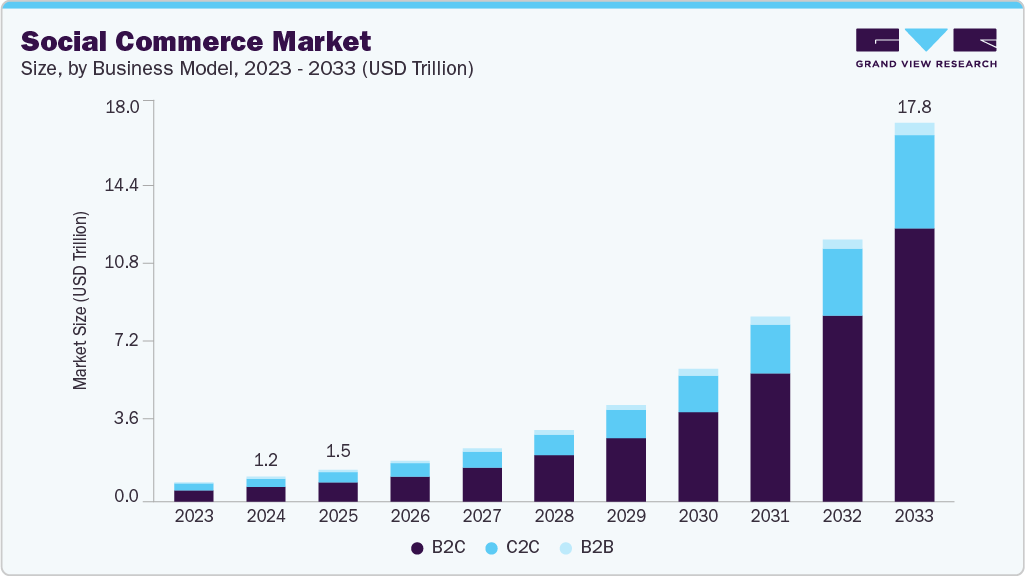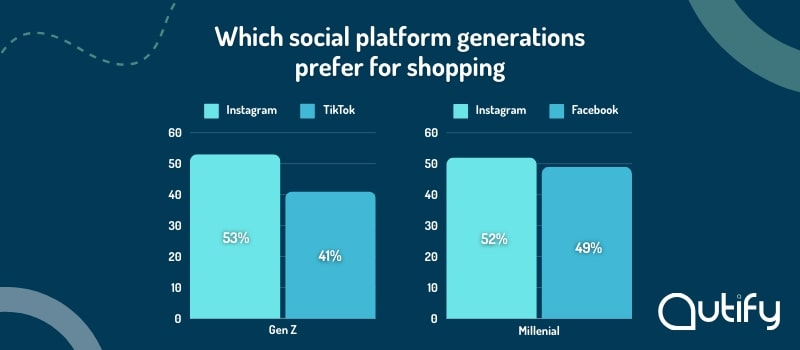According to Statista, 17% of all online sales came from social media in 2025. So, it’s pretty evident that selling online isn’t just limited to your website.
In fact, if you think logically, it’s easy to bag customers where they spend most of their time scrolling. And that’s social networks.
Social commerce, where you use social media for shopping, has been growing exponentially. The social commerce penetration rate is expected to reach 25% in 2025. That’s 1 in 4 people using social media to shop. And it’s not a Gen Z thing only. Millennials are also hooked.
The growing interest and reliance on social commerce is the reason why you see so many businesses everyday on Facebook, Instagram, and TikTok. These have become checkout channels.
It goes without saying that you need a Facebook shop integration or an Instagram shopping setup to bag more customers. The choice ultimately boils down to Shopify vs. Magento social commerce. Both big names and tough choices.
So, you need to focus on a few key factors before choosing an ecosystem.
What Is Social Commerce Integration and Why Does It Matters?

It’s basically integrating customer shopping experiences within social media and messaging apps. So, customers won’t be redirected to a separate website link. They can browse, select, and purchase products while staying on the app.
It matters because of the scale of opportunity it presents. For example, the number of social media users in 2025 was 5.24 billion. And among those users, 82% discover and research products through the platforms.
Not to mention people love the ease of shopping and payment, which brings them back again.
Integration also matters because -
- Social shoppers expect seamless experiences, from discovery to checkout, without being redirected off-platform.
- Inventory, pricing, and orders must stay synced across your store and social shops to avoid confusion and stock issues.
- Platforms like Shopify and Magento support different levels of customization and speed for social commerce extensions and apps.
Shopify Social Commerce Integration

Social commerce is built into the ecosystem. In addition, the platform supports Facebook Shop integration, Instagram shopping setup, Pinterest, TikTok and more.
The platform supports native or app-based integrations. Shopify allows you to sync your product catalog to Facebook and Instagram and enable tap to checkout from the social app.
Also, you can connect Shopify tools in one unified platform. Less hassle and better management for the business.
Key Advantages
- Shopify’s admin interface lets you manage a unified catalog which appears on social shops, reducing manual work.
- It supports native payments and redirect flows that make the social buying path simple.
- Shopify’s ecosystem is friendly to global brands of all sizes with less technical overhead.
Considerations
- Customization for social commerce flows may be limited in comparison to fully custom platforms.
- While quick to launch, for heavily tailored user experiences like regional campaigns and unique checkout flows you may hit platform limits.
Magento Social Commerce Integration
If your brand runs multiple markets, caters to complex product lines or wants full control over the social commerce experience, Magento social commerce integration offers deeper flexibility. Using extensions and custom modules, businesses can implement unique checkout flows, integrate influencer-led campaigns, and build localized social shops.
Key Advantages
- Custom modules for Facebook Shop integration or Instagram shopping setup that link your Magento catalog across platforms and track conversions.
- Advanced workflows for regional languages, localized discounts, and social-specific analytics.
- Data control: Magento allows you to fully own the integration stack, which is an advantage for enterprise brands.
Considerations
- Implementation time is typically longer than Shopify.
- Requires technical resources and ongoing maintenance.
- For smaller brands, the cost/complexity may not be justified.
Head-to-Head Comparison Between Shopify vs. Magento Social Commerce

The answer to Shopify vs. Magento social commerce depends on the context of your business. What’s your priority, speed or flexibility? These questions will take you to the right choice -
When you’re comparing Shopify vs. Magento social commerce, consider your resource level, global ambitions, and need for customization.
What Are the Best Practices for Social Commerce Launch?
- Optimize product feeds
Ensure your catalog titles, images and tags match social algorithms.
- Enable native checkout
For Instagram and Facebook, make sure purchase paths stay within the social app where possible.
- Segment for regions
Social behaviour differs globally—localize your message, offers and language.
- Track conversion data
Use UTM tags or integrations to link social purchases back to your store’s analytics.
- Manage inventory & pricing:
Whether you use Shopify or Magento, avoid overselling by syncing your main store with social channels.
- Engage via content:
Social commerce isn’t just about posting products—it’s about stories, reels, live shopping, and trust.
Possibly, invest in social listening as well and start figuring out what’s trending. You will get a fair idea about what’s the opinion on your brand as well. Since social commerce is about selling on social networks, you might as well know what’s happening there.
More on e-commerce here!
FAQs
1. What is Shopify vs. Magento social commerce?
The phrase refers to how each platform supports selling directly through social channels, how Shopify vs. Magento social commerce stacks up in terms of tools, integrations, speed, and flexibility.
2. What is Facebook Shop integration?
Facebook Shop integration connects your ecommerce store’s product catalog to Facebook’s Shop tab. You can manage inventory and pricing centrally and enable checkout within or via Facebook.
3. What does Instagram shopping setup entail?
An Instagram shopping setup allows your store products to appear in posts, stories or Reels with View Products tags. Users can tap to see a product and checkout either in-app or on your store.
4. How do I connect Shopify tools for social commerce?
To connect Shopify tools, you install apps from Shopify App Store or use built-in integrations for social channels, syncing product catalogs, checkout, and analytics to enable seamless social selling.
5. Does Magento support social commerce?
Magento payment methods and shopping extensions can be used to create highly custom social commerce integrations. With Magento social commerce integration, brands can tailor every step from catalog sync to checkout UX for social channels.







.png)
.jpg)
.png)



